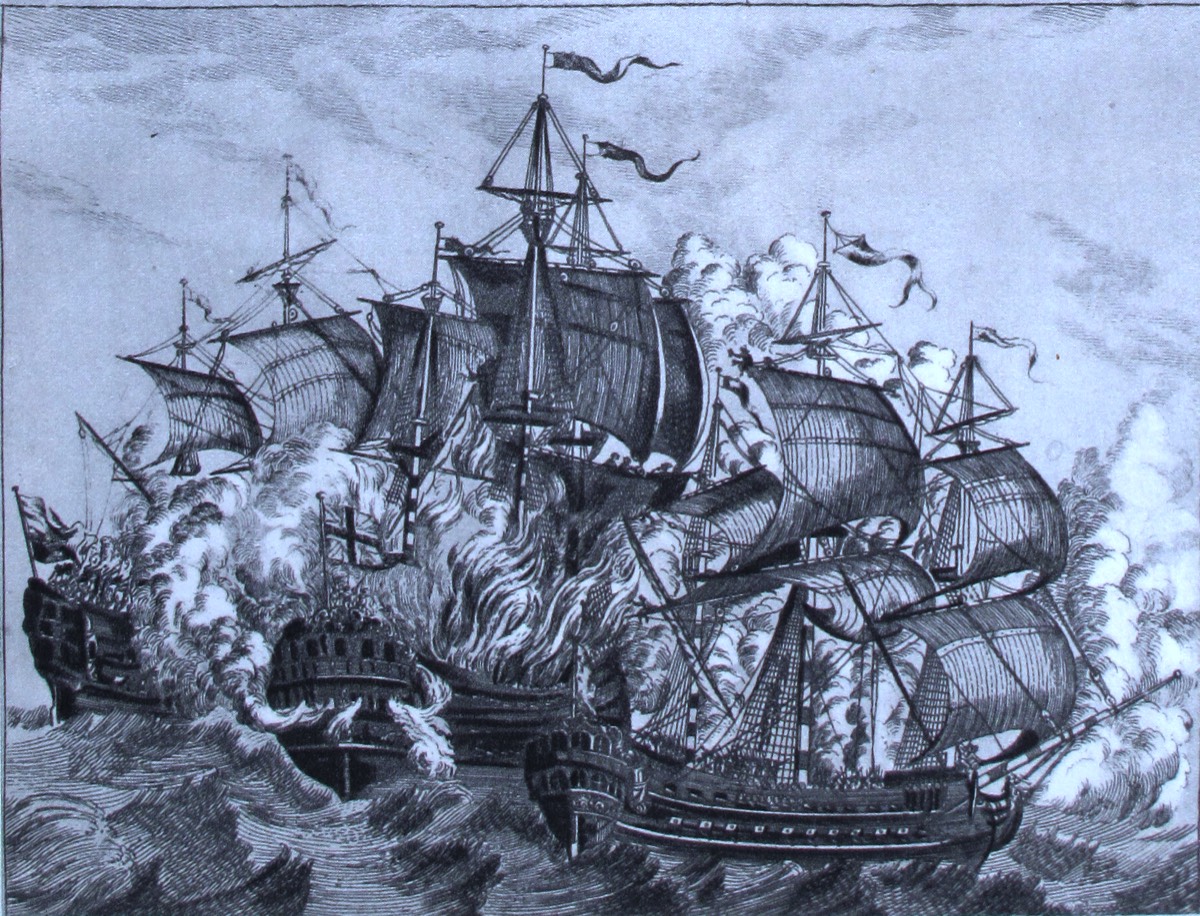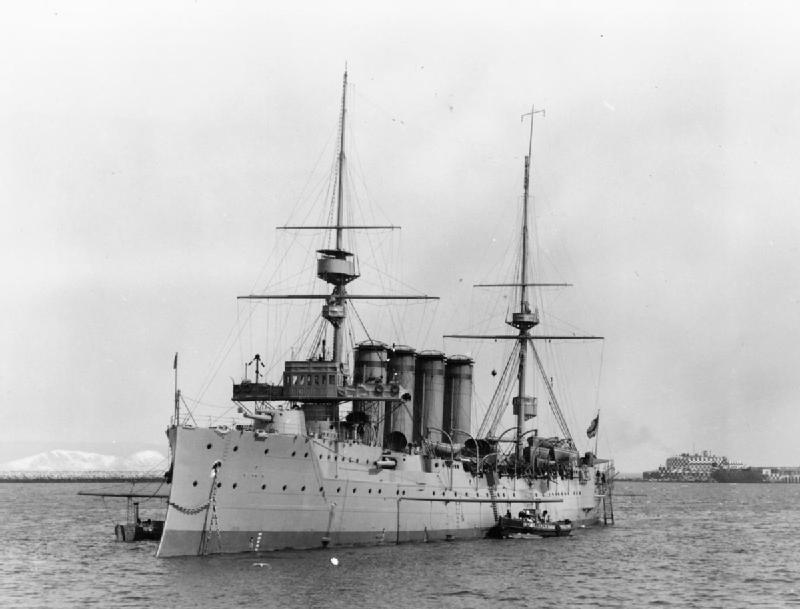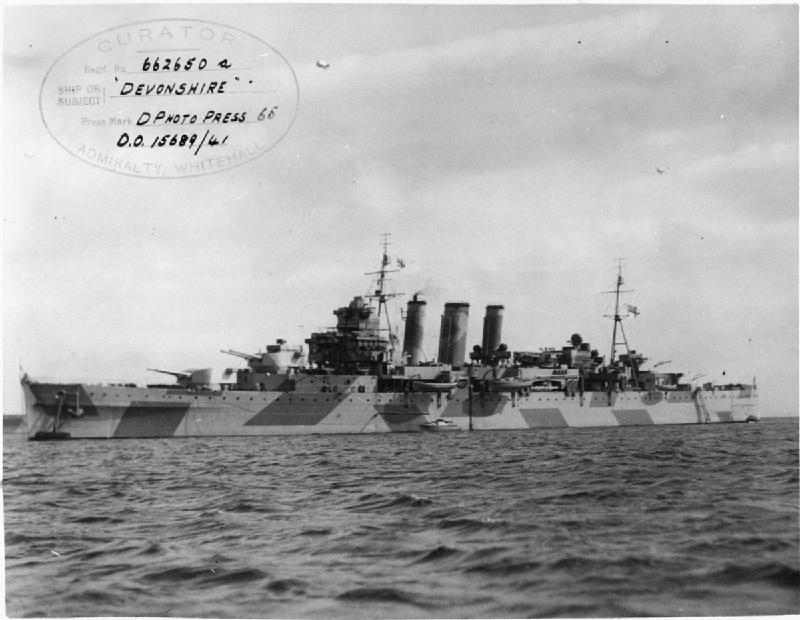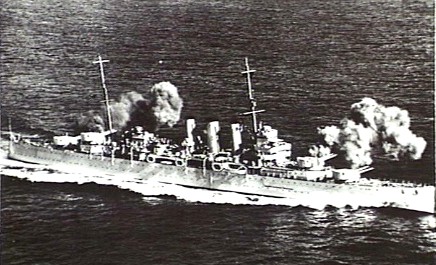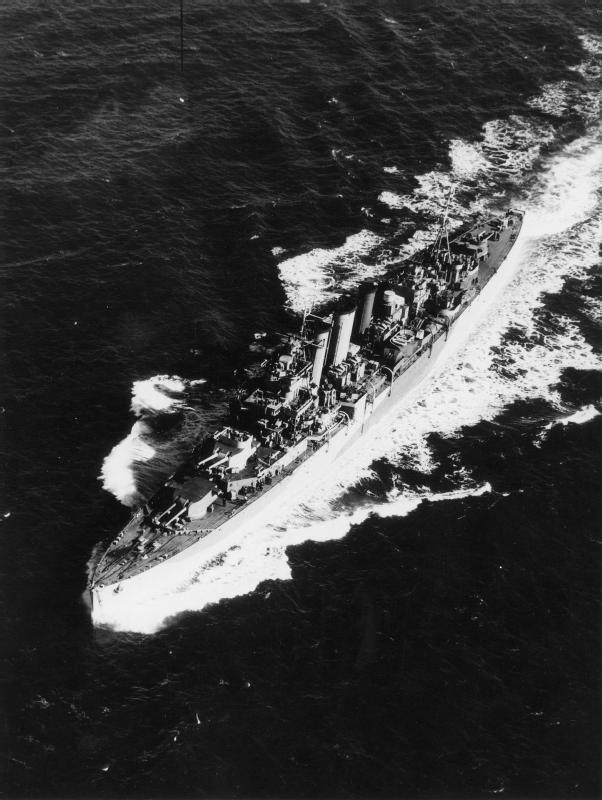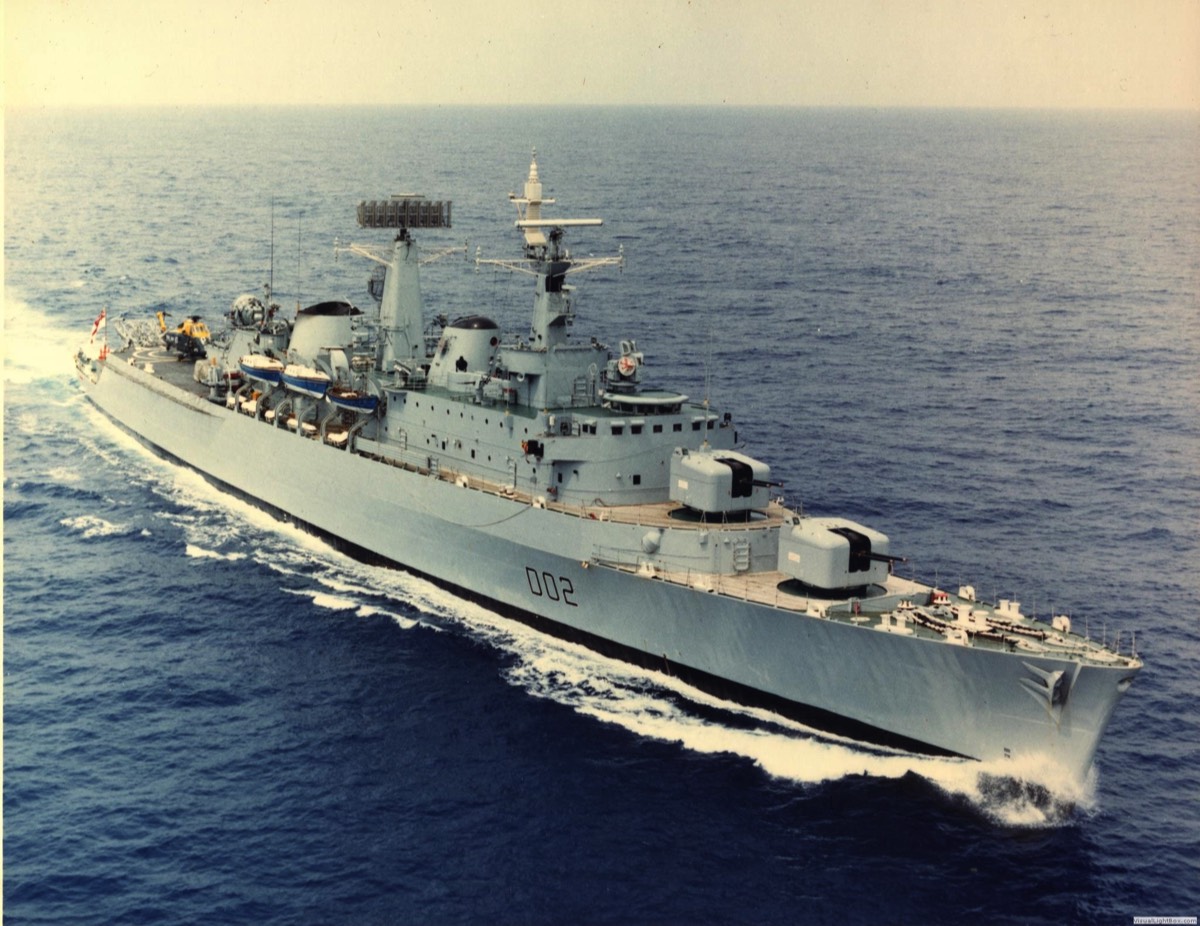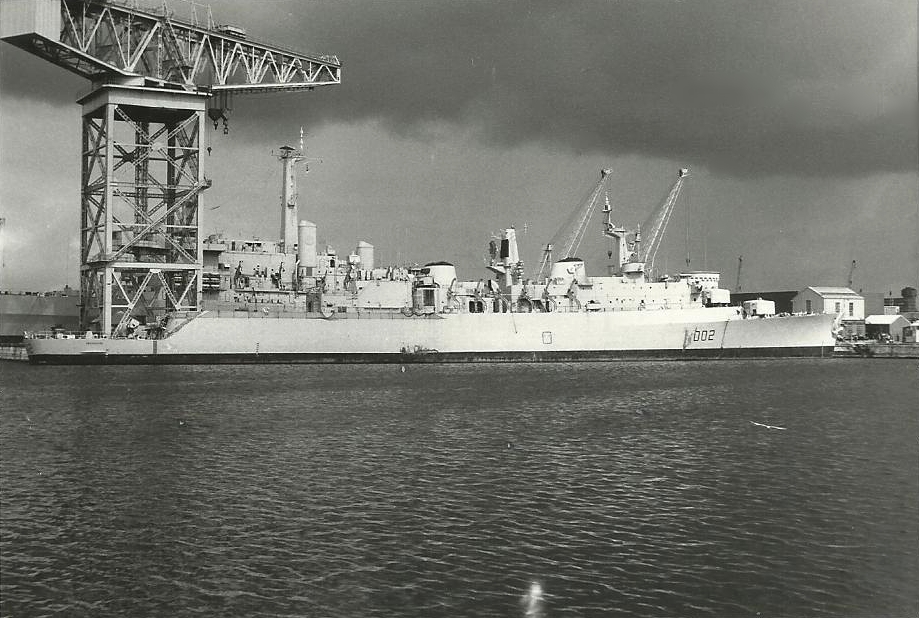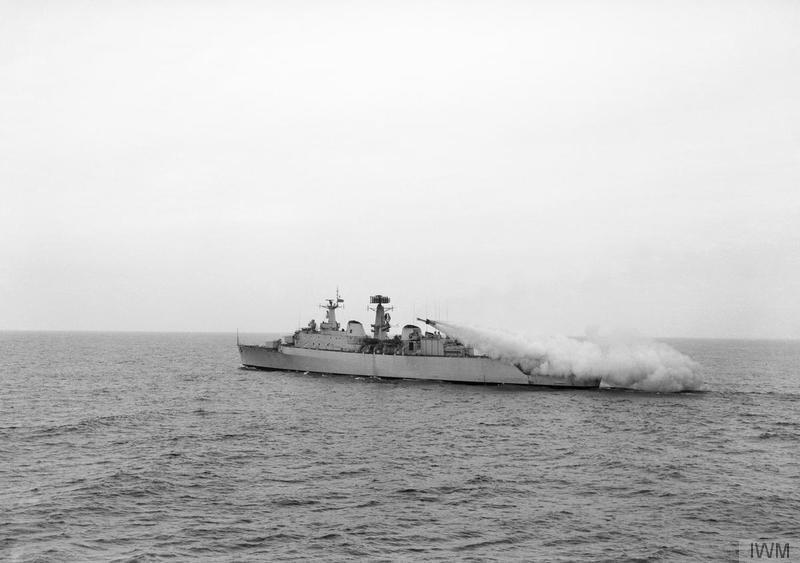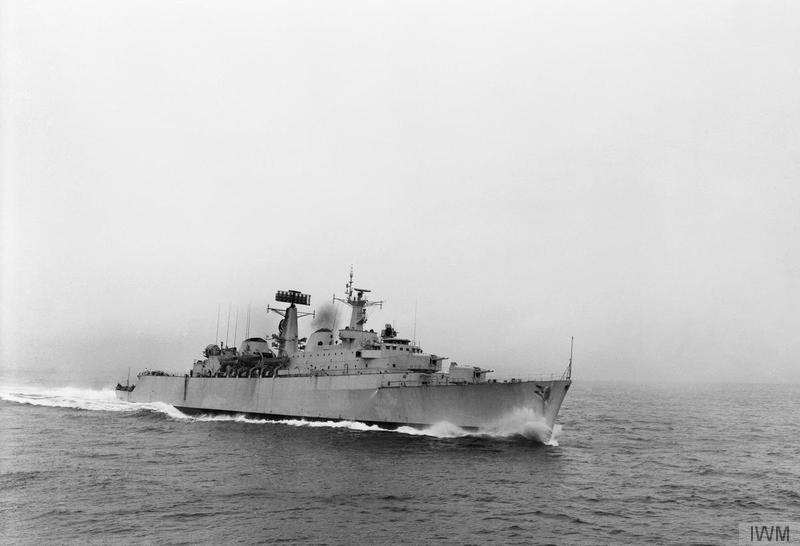John (Dusty) Miller's
HMS Devonshire
The first ship was probably named after William Cavendish, Earl of Devonshire (1640-1707) who was a prominent supporter of William the 3rd. Later ships were geographical.
Battle Honours
Finisterre 1747
Louisburg 1758
Quebec 1759
Martinique 1762.
Havana 1762
Norway 1940
Arctic 1941
Diego Suarez 1942.
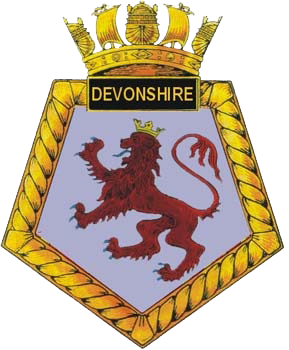
1692-1701
3rd rate. 80 guns. 1,158 tons. Compliment 500/355. Built by Wyatt, Bursledon. She was ordered on the March 12th 1691. And launched April 5th 1692. She saw service in the War Of The English Succession 1689-97, in it's later stages. 1697-August 14th, together with the Torbay, Defiance Restoration and Betty fought Commodore Baron de Pointie with five ships 200 miles SW of the Scilly Isles. An unsuccessful chase was maintained for two days after the Action. 1701 - She was broken up, and her timbers were taken to Woolwich for rebuilding.
1704-1707. 3rd rate. 80 guns. 1,220 tons. Compliment 520/360. A rebuild of the above vessel which was carried out at Woolwich Dockyard. Launched in 1704. She had a very short life but did see some action in the War Of The Spanish Succession 1702-13. 1707 - On the I October 00th she was part of Commodore Edward's Squadron that engaged a French force under the command of Captain Rene Dugay Trouin, SW of Dodman Point. During the Action following a running fight off the Lizard, Devonshire was blown up by the enemy, only two of her crew survived.
Note-some sources class the rebuild as Number 2.
1710-1740
3rd rate. 80 guns. 1,283 tons. Compliment 520/360. Built by Woolwich Dockyard. Shewas launched December 12th 1710. 1711- She was engaged in escorting store ships in connection with Rear Admiral Hovenden Walkers unsuccessful expedition to Quebec, but as she was too big a ship to navigate the St Lawrence River, and was sent home. 1717 - Devonshire was engaged in operations in the Baltic. She ended her days as a hulk at Woolwich relegated as out of service from 1740 to 1760, being sold that year for the lowly sum of £285.
1745-1772
3rd rate. 80 guns. 1,466 tons. Compliment 600. Built at Woolwich Dockyard. She was launched on July 19th, 1745. She saw service in The War Of The Austrian Succession of 1739-48. 1747 - May 3rd she was part of Vice-Admiral George Anson's Squadron that defeated the French Commodore La Jonquiere. With a large convoy 70 miles NW of Cape Finisterre, six of the escorting ships and six of the merchant ships were captured, including the French Flagship Serieux. Prize money totalled £300,000. A Battle Honour was awarded for the Action. October 14th that year, with Captain John Moore 1/c, and Flag of Rear Admiral Hawke, with others, defeated the French Commodore The Marquis de E'tanduere, escorting a large convoy off Ushant, in the battle the French ships Fougueux, Monarque, Neptune, Severne, Terrible and Trident were captured. And Devonshire gained another Battle Honour. Her next time in Action was during the Seven Years War of 1756-63. 1758 - Early in the year Admiral Boscawen in Namur, assembled an Armada of 150 transports to carry 13,000 troops from Spithead to Louisburg, to deliver a significant blow to the French Dominion in North America. On June 2nd the Fleet which included the Devonshire, anchored and landed a strong force on the SE coast of Cape Breton lsland, and fighting continued for several weeks. The Navy landed and sustained all the forces ashore, and carried out bombardments on the French, and by the end of July, the defenders were ready to surrender. The final straw came on July 24th. After a steady bombardment of Louisburg from Land and Sea, the French warships had been greatly reduced, but two ships, Prudent (74) and Bienfaisant (64), were still capable of resistance. Boscawen resolved to cut them out, and boats from the Fleet set out to do the job. The two prizes were boarded. Prudent was aground and had to be set on fire. Bienfaisant was successfully towed away. The French losses amounted to four of the line burnt and one taken, four vessels sunk in the harbour as blockships and a frigate taken. Louisburg and the whole of Cape Breton Island surrendered to the British. 1759- June 261 A British fleet that included the Devonshire, and commanded by Vice Admiral Charles Saunders in the Neptune, anchored up the St Lawrence River and landed 17,000 men below the Plains of Abraham. Which later resulted in the capture of Quebec. 1760 - Devonshire continued with operations in the St Lawrence and the capture of Montreal. 1762 - February 16th part of Rear Admiral George Rodney's Squadron at the capture of the French Island of Martinique in the West Indies, the force then went on to conquer St Lucia, St Vincent and Grenada. In June Devonshire was part of a British Squadron comprised of twenty-two ships of the line and thirty other ships and 100 transports, commanded by Admiral Sir George Pocock in Namur, that landed troops on the island of Cuba, and two months later on 13th August Havana fell, of the twelve Spanish ships in the harbour, nine of the line were captured and the other three sunk. 1772 - Devonshire was finally broken up at Portsmouth.
1804-1804
A mercantile vessel was purchased in 1804 for use as a fireship during the Napoleonic War. She was expended on October 3rd the same year at Boulogne.
Note. This vessel does not appear registered in most sources.
1812-1869
3rd rate. 74 guns. 1,742tons. Compliment 500. Built by Barnard, Deptford. Laid down February 1810. Launched September 23rd 1812. This ship had an uninteresting history. 1849 - She was lent to the Greenwich Seaman's Hospital as a temporary hospital ship. 1854 - June 21st" she commissioned as a Prison Ship for Russian Prisoners of War at Sheerness. From 1857 to 1868, she became a School Ship for the Steam Reserve at Sheerness, and she was finally broken up there, completing on the June 05th 1869.
1904-1921
1st Class cruiser. I 0,850 tons. Complement 655. She was built by Chatham Dockyard at the cost of approximately £850,000. Laid down March 25th 1902. And launched on April 30th 1904. She commissioned at Chatham on the March 25th 1905 ·and entered the Reserve not being completed until the August 24th. 1905 - October 24th Commissioned at Chatham for service in the 1 SI CS Home Fleet. 1907 - March she recommissioned at Chatham for service in the 2nd CS Home Fleet, later transferring to the Atlantic Fleet. 1909 - March 19th again reduced to the Reserve Division, this time at Devonport. 1911 - The cruiser was present at King George V's Coronation Review at Spithead, June 23rd/24th. 1912 - Part of the 5th CS. 1913 - 3rd CS, Home and Grand Fleet. She saw service during the First World War of 1914-18.
1914 - Sent to Scapa Flow. And carried out patrol duties, during which on the August 06th she captured a German merchant ship. September she was refitted at Cromarty. 1915 - Operations off the Yorkshire coast. 1916- Operations off Norway. April stationed at the Nore. May began refit, joining the 7th CS in July. December joined the America and West Indies Station. 1919 - July returned to Devonport.. 1920 - she was placed on the sale list. 1921 - May 09th sold to T. W. Ward Ltd, Barrow. 1923 - October broken up for scrap.
1927-1954
Cruiser. 9850 tons. Compliment 700. Built by Devonport Dockyard. Laid Down on March 16th, 1926. Launched on October 23rd by Lady Elizabeth Mildmay. 1929 - She was completed on the March 8th and commissioned on the 19th for service with the 1st CS. The ship was presented with a silver replica of Drake 's Drum. ( but after several accidents onboard, the drum was removed as it was considered a jinx). 1st May ith after carrying out trials at Portland, Devonshire sailed for Gibraltar, and with the Sussex underwent an eight-week work up before sailing for Malta on July 8th arriving there on the 11th to join the 1st CS Mediterranean Fleet. July I 9th with the rest of the Fleet sailed for manoeuvres in the Aegean. On the 26th on leaving the exercise area to form ' line ahead ' for a gunnery shoot, Devonshire and Sussex were involved in a slight collision, no serious damage was done, and the exercise continued. As Devonshire fired her first broadside, a huge explosion shook the ship. A faulty breech mechanism in X turret had caused a shell and some cordite bags to ignite, the force of the explosion blew the roof off the gun turret and started fires in the gun house and pump room. Fortunately, these were soon extinguished, but the explosion took a heavy toll of the Royal Marines who were manning the turret. One officer and six men were killed instantly, one of them being blown overboard. Devonshire made for the Greek port of Volos where 17 injured men were transferred to the hospital ship Maine. However, 11 of these subsequently died, and 16 of the victims were buried at Volos with full military honours. Devonshire, with X turret awry, returned to Malta and from there proceeded to Devonport where on August 14th her tragic first commission ended, and she paid off for refit and repairs. Between 1931 and 1934, Devonshire spent periods with the 1st CS in the Mediterranean and the 5th CS on the China Station. 1935 - July, present at the Silver Jubilee Review of the Fleet at Spithead. 1936 - Devonshire was involved in the removal of refugees during the Spanish Civil War, then refitted. 1937 - May, present at the Coronation Review of the Fleet at Spithead. 1938 - Mediterranean Fleet. 1939 - Mediterranean Fleet. Ist CS. September at Alexandria. In November the cruiser returned home and became Flagship of the 1st CS Home Fleet. On the November 25th Devonshire was part of a force that sailed from the Clyde to form a patrol line to search for the German ships Scharnhorst and Gneisenau, following the sinking of the Rawalpindi. 1940 -1st CS. Home Fleet. March was operating on patrols covering Scotland, the Faeroes and Iceland. April stood by at Rosyth for the Norwegian Campaign. April 3rd sailed from Rosyth as part of a battlefleet as escort to two large minelaying groups which were to lay mines barrages off the Norwegian coast. April 7th at Rosyth loaded with troops of the 115th Battn Royal Leicester Regiment, ready to transport them to Norway, they were later disembarked, when on the 8th the Devonshire put to Sea with other Home Fleet units to answer distress calls from the Gloworm. 9th with other units off the coast of Norway in the opening moves of the Campaign, Devonshire was attacked by German aircraft and received slight damage from a near miss. 11th carried out a search of the Trondheim Leads for enemy shipping, later returning to Scapa Flow. April 29th sailed from Scapa with other units and troopships to evacuate Namsos. May 2nd sailed from Namsos with the evacuation fleet for the UK, during the withdrawal Devonshire was subjected to a two-hour bombing attack but received no damage. 31st at Narvik. June 1st it was decided to withdraw from Norway. The Devonshire sailed for Tromso to pick up the King of Norway and members of the Norwegian Government for passage to the UK and left with them on the 6th. On completion of her part in the Norwegian Campaign; the cruiser sailed for the Biscay area to give additional protection to Convoy US.3 a troop convoy from Australia, she was with the escort from 12/14th. On August 31st Devonshire sailed from the UK with other fleet units, as escort to troopships for the Dakar operations. She arrived at Freetown on September 14th. The abortive operations took place on the 23/24th, Devonshire bombarded Dakar harbour with the Australia and three destroyers on the 24th besides damage to installations, a French destroyer was damaged. The force withdrew to Freetown on the 25th. October Devonshire transferred to the South Atlantic Command. On the 3rd left Freetown for Dubai in the Cameroons, with a destroyer escort to the transport Westernland, with 1,564 troops to protect the French Cameroons, the troops were landed on the 19th. November carried out a blockade of the coastal area of Gabon. November 7th the sloop Milford and the Walrus aircraft from Devonshire attacked the French submarine Poncelet, in the Gulf of Guinea, forcing her to scuttle. 1941 - South Atlantic Command. January 6th to 29th carried out a search operation in the South Atlantic for the German raider Kormoran, with no success. February returned to the UK and began a refit at Liverpool on the 19th which lasted until late May. On completion of her refit, she resumed her position with the 1st CS Home Fleet. July 23rd sailed from Scapa with the Victorious and Furious, for an FAA attack on Petsamo and Kirkenes, Operation EF. On the 25th off Seidisfiord. On the 26th Walrus aircraft from Devonshire and Suffolk carried out anti-submarine patrol s. After the FAA attack on the 30th, the force returned to Scapa. August 23rd left Scapa, for Operation Dervish, the first experimental convoy to North Russia, Devonshire, Suffolk together with three destroyers provided distant cover from the 24th to the 30th • There was no enemy activity. Between the August 30th and September 14th the carrier Argus, with other units, conveyed Hurricane aircraft and associated Royal Air Force personnel to Archangel, Operation Strength, again Devonshire was part of the covering force. During the return passage, air attacks were made in the Bodo area. Arrived back at Scapa on the 14th • October returned to the South Atlantic Command. Captain R.D. Oliver I/c. From October 29th to November 7th with the Colombo took part in Operation Bellringer, to intercept Vichy French convoys homeward bound. A convoy was intercepted on November 3rd, the French escort left after some refusal, and Devonshire together with the South African escort Steenberg, escorted the French Cap Tourane into Port Elizabeth, arriving on the 6th. Later on the 22nd, the cruisers aircraft spotted the German raider Atlantis refuelling the U-boat U.126, Devonshire closed at full speed and sank the enemy with gunfire, but didn't 't remain to pick up survivors, because of the presence of the U-boat. 1942 - South Atlantic Command. January 24th to March 7th Devonshire was refitted at Norfolk, Virginia in the USA. On completion, she was allocated to the 4th CS Eastern Fleet. April 25th sailed from Durban with other units as part of Operation Ironclad, the invasion of strategic ports in Vichy held Madagascar. In the follow up to this Operation, she escorted troop convoys including the Queen Mary, between Suez and Simonstown. June 6th at Mombassa. 1943 - Eastern Fleet. 4th CS. January took part in two fleet exercises with other units operating from Kilindini. February 5th joined the escort of Convoy 'Pamphlet ', 30,000 men of the Australian 9th Division, off Aden on route to Australia. Devonshire left the station early in the year and by May 18th had begun a refit on the Tyne, which lasted into the following year. 1944 - Refitting on the Tyne. March 20th completed a refit and after work up joined the Ist CS Home Fleet. 17th July Devonshire was part of the cover for the FAA attack on the German battleship Tirpitz in Kaafiord. August 9th part of the covering force for FAA attacks on German airfields at Gossen near Kristiansund. 17th1 part of the early cover for Arctic Convoys JW59 and RA59, in conjunction covered FAA attacks from carriers again on Tirpitz, Operation Goodwood, 22/29th Returned to Loch Ewe on completion. September 05th with Kent and Berwick, formed part of the escort for the Queen Mary sailing from Greenock, carrying the Prime Minister to Halifax, Nova Scotia, Operation Octagon. Also in September took part in Operation Begonia, escort to minelaying operations in Aramsund Channel, Norway. October refitting at Rosyth, completing in time to provide cover for another FAA attack in the Aalesund area. December 14th, Devonshire formed part of a squadron operating against enemy shipping off Norway, during this Operation she came under heavy attack by JU-88 torpedo bombers, one of which she shot down. , no damage to the cruiser. 1945 - I st CS. Home Fleet. May 4th part of the covering force for FAA attacks on a U-boat depot ship at Kilbotn, near Harstad. Trumpeter 's aircraft sank the depot ship Black Watch and the U.711, and aircraft from the Queen sank an 860-ton merchant ship. 7th left Scapa with Home Fleet units to cover the entry of minesweepers into the Skagerrak, after the end of hostilities with Germany, returning to Scapa on the 10th • On the 12th sailed for Norway as escort to ships with stores and Crown Prince Olaf on board, the Ariadne, 13th entered Oslo, during the visit to Oslo the cruiser was open to visitors, over 2,800 people visiting the ship each day. From Oslo Devonshire sailed for Copenhagen where the two German ships Prince Eugen and Nurnburg surrendered to the Devonshire, and on the May 22nd accompanied by the Dido. A destroyer escorted the German ships to Wilhelmshaven, the two British cruisers then returning to Rosyth. In June Devonshire was allocated to the Plymouth Command. During the latter half of the year, she made a number of trooping voyages east of Suez, on one occasion returning 700 naval ratings from Sydney to Devonport for demobilisation. During the outward passage to Sydney, she assisted in the search for survivors from the British steamer Empire Patrol, which had caught fire and sunk off Port Said while carrying over 500 Italian refugees from Ethiopia. 1946 - Plymouth Command, continuing trooping duties. In April on her return from her last trooping voyage to Colombo, the cruiser entered Rosyth and began conversion and fitting out as a Cadet Training Ship, to replace the Frobisher. 1947 - Under conversion at Rosyth. April completed and took over her new role. Devonshire's first training cruise began in the Autumn; she visited Berehaven in Bantry Bay, Ireland. From Ireland, she steamed to the Mediterranean where she visited Ajaccio, Malta and Mers el Kebir, before returning to Devonport for Christmas leave. 1948 - Officer Cadet Training Ship. During a cruise to the West Indies, she protected the British interest at Belize during the unrest in British Honduras s. 1949 - Officer Cadet Training Ship. Summer Cruise, sailed from Devonport in April for the Baltic ports. Visits were made to Stockholm, Copenhagen and Amsterdam. British ports included Portsmouth, Torquay and Bantry Bay. Returned to Devonport in August. Sailed in September for Autumn Cruise to the Mediterranean, visits made to Gibraltar, Villefranche, Sorrento, Malta and Augusta. 1950 - Officer Cadet Training Ship. A winter cruise took her to the West Indies; calls included Barbados, Jamaica, Trinidad and Grenada. Summer Cruise to Oslo, Gibraltar and British seaside resorts. Autumn Cruise to the Eastern Mediterranean, visits to Istanbul, Athen s, Cyprus and Crete. 1951 - Officer Cadet Training Ship. Captain R.G. Onslow I/c. January visit to the West Indies, the first port of call was to Ponta Pierre, Trinidad. At Grenada she landed landing parties to protect the airport during a strike, she also called at Barbados, and Gibraltar on the return trip. Summer cruise to Scandinavian ports and British seaside resorts. 1952 - Details required, probable refitting. 1953 - Officer Cadet Training Cruiser, Plymouth Command. Captain W.G. Crawford I/c. June, she was present at the Coronation Review of the Fleet at Spithead. Returning to Devonport via Torquay on September 07th the old cruiser transferred her ships company to the Triumph and paid off into Class 4 Reserve. 1954 - Plymouth for disposal. June 16th sold to the British Iron & Steel Co. December I 0th left Devonport under tow for Newport, Monmouthshire, and arriving on the 12th at John Cashmore Ltd for breaking up.
1960-1984
Guided-missile destroyer. 6,200 tons. Complement 440. Built by Cammell Laird, at Birkenhead. Laid down March 9th 1959. Launched by HRH Princess Alexandria on June 10th, 1960. 1962 - Completed in November, and after completing builders sea trials, she was handed over to the Royal Navy on the November 15th and commissioned. 1963 - She served in the Mediterranean for a period, before going over the Atlantic to visit Philadelphia and Washington in the USA. 1964 - January she took part in Exercise Phoenix in the Western Approaches with the Lion and other units, later going to the Far East. 1965 - Captain D. Williams I/c. The Far East. August passage from Aden to Singapore. September, at Tokyo for the Trade Fair. November took part in the three week Exercise Warrior. December carried out a tour of Australian ports. 1966 - Far East. March acted as Guardship at Taurau. June took part in Exercise Sea Imp in the South China Sea. July 15th arrived at Portsmouth after 12 months the Far East, 60,000 miles steamed and among the visits were, Borneo, Philippines, Okinawa, Hong Kong and Bangkok. August took part in Navy Days at Portsmouth. At the end of the month, Captain Leslie I/c. Carried out a goodwill visit to Leningrad, Helsinki and Gdynia. During the visits, she collided with the tanker British Sovereign in the River Elbe. 1967 - The Devonshire left the UK in December for the Far East, spent Christmas at Simonstown. 1968 - Far East. February at Sydney after major exercises in Australian waters. March 19th arrived at Singapore, then paid visits to Hong Kong, Tokyo, Subic Bay and Sydney. July left Singapore for home, calls at Gan, Diego Suarez, Simonstown, Dakar and Gibraltar. Arrived Portsmouth in September and began a major refit. 1969-1970- Under major reft. 1971 - May 25th' recommissioned after the refit. Captain S.R. Sanford I/c. Carried out work up from Portland. 1972 - Left the UK for a nine-month deployment to the Far East, visiting St Helena and Simonstown on route. During the deployment carried out various exercises in the Pacific, and made visits to Hong Kong, Japan and Australia. 1973 - January 18th arrived Portsmouth from the Far East deployment. At the beginning of July took part in JMC.168 exercise off Scotland, on completion gathered at Rosyth for the Sea Day Operation Sally Forth 73, on the July 24th in home waters. After summer leave it was to the Mediterranean, took part in Exercise Deep Furrow in the Aegean, and a September visit to Istanbul. 1974 - February 15th to the Caribbean with other units, visit the Virgin Islands for the Official Send-Off of Admiral Pollock, the outgoing First Sea Lord. July 15th to the Mediterranean for the Cyprus Emergency sailed from Malta with the Hermes and other units, with 41 Commando to Cyprus to protect and evacuate British Nationals on the July 23rd during the Turkish invasion. Altogether the British forces evacuated 7,526 people, Devonshire playing her part with her Wessex helicopter running a shuttle 'taxi service ' to the ship. 1975 - Took part in the NATO Exercise Ocean Safari in Northern waters. 1976 - September 25th to December 21st took part in a reduced Group Deployment TG.317.4 to the Middle East. The group sailed from Portsmouth to join the Ark Royal and on to Lisbon for a three-day visit, on sailing from Lisbon, Devonshire was suffering with boiler trouble and was detached from the group and returned to the UK for repairs. October 10th rejoined the Task Group and headed for the Suez Canal, arrived at Mombassa on the October 22nd. Middle of November began the CENTO Exercise Midlink from Karachi. December 8th at Alexandria, then via Gibraltar arrived back home on December 21st 1978 - January took part in Exercise Spring Train in the Mediterranean and Eastern Atlantic. Then to The Caribbean as West Indies Guardship. During the deployment visited Grand Cayman, Georgetown, Guadeloupe and Antigua. Arrived back in Portsmouth in July and was paid off for disposal. 1979 - Portsmouth for disposal. A proposed sale to Egypt was cancelled, and she was laid up in Fareham Creek, where she lay until 1984 -1. She was selected as a target, and towed out into the South Western Approaches, and struck by missiles from Royal Navy and RAF aircraft, and then finally sunk by a torpedo from the submarine Splendid.
